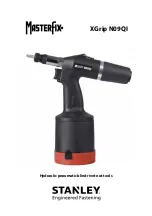
MHH Engineering Co Ltd, Bramley, Guildford, Surrey, GU5 0AJ, UK Tel: **44(0)1483 892772 Fax: **44(0)1483 898555
E mail:
http: //www.torqueleader.com
Issue No:
1
Data Sheet 008
Date:
April 2000
Page 1 of 2
TSC Wrenches - All Models
Re-calibration Procedure
Test Methods:
As adopted and stipulated by Mountz, and in accordance with ISO 6789 recommendations for
the testing of TSC Wrenches
1. Testing should be done at normal ambient temperature of 20ºC ± 5ºC after a period of
stabilisation and with the tool being maintained within this temperature band throughout the
test.
2. A good quality Electronic Torque Analyser should be used for testing with an accuracy of
±0.25% of reading ±1 LSD (Least Significant Digit).
3. The Transducer should be mounted with its axis in a vertical position.
4. The Torque Analyser should have a “Peak Hold” facility, as it is impossible to read the
maximum torque achieved in “Track Mode”. (It should be remembered that it is impossible
to over-torque with TSC/P’s and similar cam-over mechanism wrenches unlike “Clicker”
wrenches that become solid levers after achieving the pre-set torque value).
5. Under test, the wrench should be operated without pauses to give a slow, consistent and
smooth action.
It should be realised that currently all Electronic Torque Analyser manufacturer’s quoted
accuracies refer to results obtained during
Static
testing. In practice most torque tool testing
is done
Dynamically
using Transducers - for which there are no dynamic Calibration
Standards at present.
It is also known that Electronic Torque Analysers with differing sampling/response rates will
provide differing torque readings for the same tool at the same setting!
Procedure:
1. Peel back the rubber hand grip from the end of the tool to reveal the three equally spaced
socket set screws located in the adjusting sleeve.
2. Ensure that the red lock knob is pulled fully out and engage the tool with the test device.





















